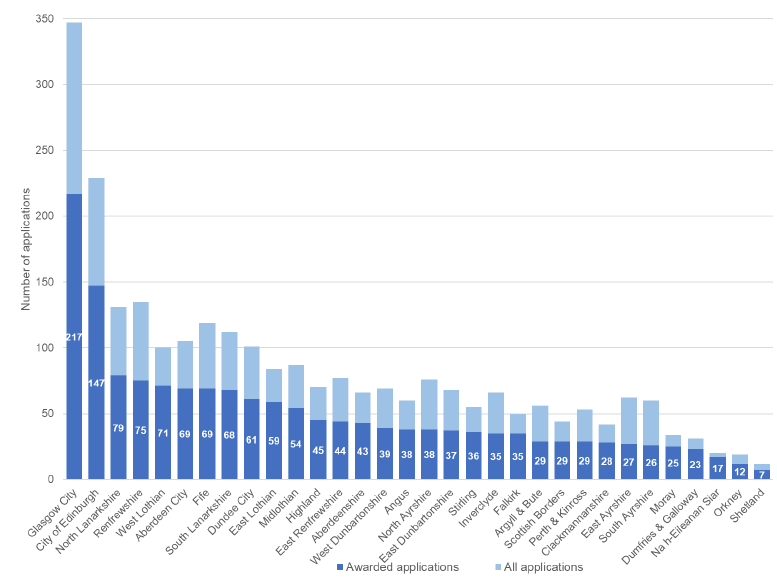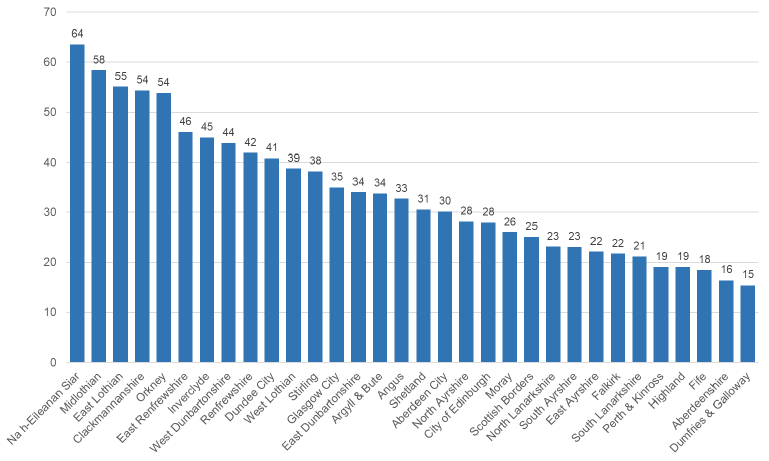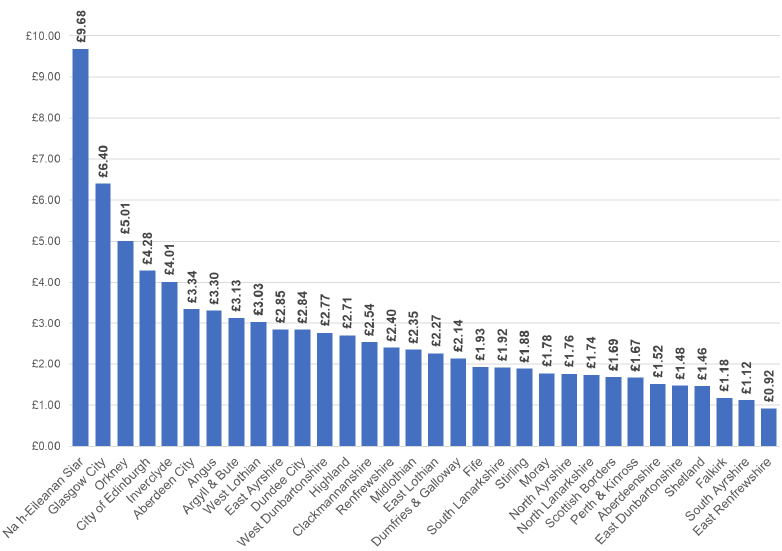Wellbeing Fund: analysis of awards
Analysis of the data on applications and awards made through the Wellbeing Fund Open Application Process and the Small Grants Fund. These funds were part of the Scottish Government’s initial 350 million overall package of funding support to communities, in response to the COVID-19 pandemic
4. Analysis by geography
Organisations applying to the fund were asked to specify whether they operated across Scotland, across more than one local authority area, across one local authority area or within a specific community. The data on awards for each local authority presented here exclude applications from organisations delivering programmes across Scotland. The data include organisations which specified one or more specific local authorities as their programme delivery areas. It also includes organisations that said they were delivering programmes in a specific community, based on which local authority they are located in. Annex 1 provides more data about the awards for each local authority.
| Operating area of applicant organisation | Number applications | % applicants | Number approved | Amount awarded | % of total value awarded | Average award size |
|---|---|---|---|---|---|---|
| Across Scotland | 298 | 19% | 173 | £5,676,990 | 26% | £32,815 |
| Across several local authority areas | 355 | 23% | 215 | £6,124,492 | 28% | £28,486 |
| Across one local authority area | 526 | 34% | 338 | £6,203,216 | 29% | £18,353 |
| Within a specific community | 384 | 25% | 229 | £3,577,634 | 17% | £15,623 |
| Total | 1,563 | 955 | £21,582,333 | 100% | £22,599 |
An important limitation is that the available data do not provide detailed information about how awards to organisations working across more than one local authority will be spent between the relevant local authority areas specified in their application. For the purposes of this analysis we have notionally allocated the amounts awarded between the relevant local authorities in proportion to each local authority's population. As such, the allocations of awards to local authorities presented here should be seen as indicative only.
Organisations from across Scotland were encouraged to apply for the Wellbeing Fund Open Application Process. However, in practice there was a high level of variation in the rate of applications and awards to organisations from different areas – even when relative population size is taken into account. This may reflect variation in levels of need, variation in Covid-19 case rates, awareness of the funding, ability to access alternative funding or support, density of third sector organisations and other factors. It is important to note that all applications were considered on their own merits – not in relation to other applications. Based on analysis of the first round of funding, and on feedback from the TSIs, funders were aware of emerging gaps and needs, and made efforts to address these in the second round through strengthened guidance to applicants and awareness sessions with assessors.
The highest numbers of applications and approved applications were from organisations delivering projects in Glasgow and Edinburgh, the largest centres of population and the places with the highest numbers of third sector organisations (Figure 3). In absolute terms, organisations working in Glasgow City and the City of Edinburgh received the most funding, £4 million and £2.25 million respectively.
Organisations delivering projects in island areas and more rural areas such as Dumfries and Galloway and Scottish Borders submitted the lowest numbers of applications.
The highest rate of applications, considered per 100,000 people,[7] came from organisations working in Midlothian (94), Orkney (85) and Inverclyde (85). The lowest rate of applications per 100,000 people came from organisations working in Dumfries and Galloway (21), Aberdeenshire (25) and Highland (30).

Figure 4 shows the rate of awards made per 100,000 people, to organisations working in different local authorities. The lowest rate of awards was to organisations working in Dumfries and Galloway, with 15 applications approved per 100,000 people; other local authorities with low rates of awards per 100,000 people included Moray (16), Fife (18), Highland (19) and Perth & Kinross (19). The highest rate of awards per 100,000 people went to organisations working in Na h-Eileanan Siar (64), Midlothian (58), East Lothian (55), Orkney (54) and Clackmannanshire (54).

Figure 5 shows the amounts of money awarded to organisations working in different local authorities, by head of population. Allocated on this basis, relatively higher levels of per capita funding went to organisations working in Na h-Eileanan Siar, Glasgow City, Orkney, Edinburgh and Inverclyde. The lowest levels of funding per capita went to organisations working in East Renfrewshire, South Ayrshire, Falkirk, Shetland and East Dunbartonshire.
In conclusion, the picture at the level of local authorities depends on what indicator is considered. Consideration of the rate of applications, the rate of successful applications and the amount awarded per capita each give a different picture. The outcomes also depend on the density of third sector organisations in different areas, how many organisations in each local authority applied to the Fund and how much they applied for.

Contact
Email: socialresearch@gov.scot
There is a problem
Thanks for your feedback